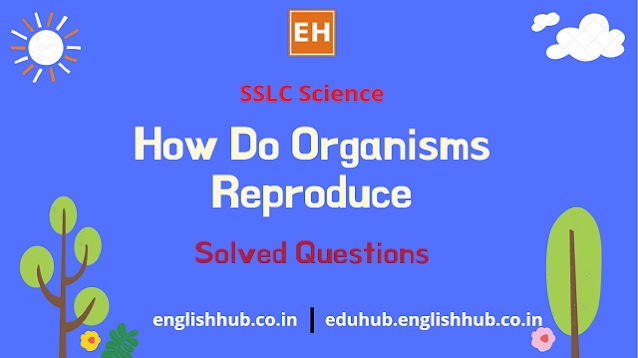How Do Organism Reproduce | Solved Questions:
SSLC Science Solved Questions/Model Questions and Answers (Q&A) on the lesson: How Do Organism Reproduce for the SSLC English Medium students have been updated in this post below. The students of SSLC can make use of this Online Study Package to get good scores in the SSLC examinations.
Teachers also can help the students to access this platform to use this FREE Online Study Package anywhere and any time.
HOW DO ORGANISM REPRODUCE
One Marks Questions
Answer: Binary fission
Answer: Budding
Answer: sporangia
Answer: Regeneration
Answer: Ovule
Answer: Ovary
Answer: testis
Answer: placenta.
Answer: Urethra
Answer: D.N.A is the carrier of hereditary information from parents to its next generation.
Answer: Vegetative propagation
Answer: The micropyle opening serves as a passage for the entry of the pollen tube into the ovule.
Answer: Fallopian tube.
Answer:
The time period from the development of the foetus inside uterus till birth.
Answer:
IUCD – Intra-Uterine Contraceptive Device.
HIV – Human Immunodeficiency Virus.
Answer:
Plumule develop into stem Radical develop into root
Answer:
Self-pollination
Cross-pollination
Answer: multiple fission
Answer: Fragmentation method.
Two Marks Questions
Answer:
i] Only one parent is required for reproduction this eliminates the need for special mechanisms.
ii] Many plants are able to tide over unfavourable conditions.
iii] Plants that do not produce seeds are propagated by this method.
iv] The trait of the parent plant is preserved.
Answer:
Four modes of asexual reproduction are
i] Binary fission
ii] Budding
iii] Multiple fission
iv] Fragmentation
| Binary fission | Multiple fission |
|---|---|
| It is the division of one cell into two similar or identical cells. | It is the process, in which many individuals are formed from a single individual |
| The nucleus first divides automatically into two, followed by the division of the cytoplasm | The nucleus of the cell divides repeatedly producing many nuclei. |
Answer: pollen grains fertilize the egg cell present in the embryo sac.
Answer:
sperms contain two types of chromosomes that are X- chromosomes and Y-chromosomes.
Egg contains one type of chromosomes that is X- chromosome.
Answer:
a) placenta: helps in the transportation atom of glucose and oxygen from the mother to the embryo. Waste generated by the embryo is removed by transferring it to the mother's blood.
b) fallopian tube: an egg is carried from the ovary to the uterus. Fertilization occurs here.
$ads={2}
Three Marks Questions
Answer:
reproduction is a biological process by which new individuals of the same species are produced by the existing organisms.
Populations of organisms live in well-defined places called niches in the ecosystem using their ability to reproduce.
Reproduction involves DNA copying which is the source of information for making proteins thereby controlling body design.
These body designs allow the organism to use a particular niche for the stability of the population of a species.
Minor variations may also lead to the stability of the species.
Answer:
DNA copying is essential because it makes possible the transmission of characters from parents to the next generation.
The advantages of sexual reproduction over asexual reproduction are sexual reproduction gives rise to variations that are essential for the evolution as well as the survival of species under unfavourable conditions.
Pollination: The transfer of pollen grains from the anther to the stigma is called pollination.
the two types of pollination are
self-pollination: when the pollen grains from the stamens of a flower fall on the stigma of the same flower then self-pollination occurs.
Cross-pollination: when pollen grains from the stamens of a flower fall on the stigma of another flower then cross-pollination occurs.
Four Marks Questions
Answer:
a) fission, budding, fragmentation, spore formation, vegetative propagation.
b) budding: in hydra, a bud develops as an outgrowth due to repeated cell divisions at one specific site. these buds into tiny individuals, when fully mature they are detached from the parent body start independent existence.
regeneration: planarium is a type of flatworm. the capacity to regenerate its lost body part. when the flatworm cut operating the head from the tail, the tail will regenerate The Lost head and the head will regenerate The Lost tale this process is known as regeneration.
Answer:
a) AIDS, syphilis.
b) surgery can prevent frequent or unwanted pregnancies. however, this method used by people for gender-selective abortion as happens in illegal female foeticides. as a result of prenatal gender determination, the child gender ratio is declining at an alarming rate in many of our societies. therefore prenatal determination has been prohibited by law.
c) creating a mechanical barrier so that the sperms do not reach the egg.
this is done with a condom that is around the penis or a similar device that is placed in the vagina.
changing the hormonal balance of the body so that fertilization cannot occur this is done with the help of oral contraceptive pills.
contraceptive devices like loop or copper-T are placed in the uterus to prevent pregnancy.
Surgical methods like vasectomy in males can tubectomy in females.

